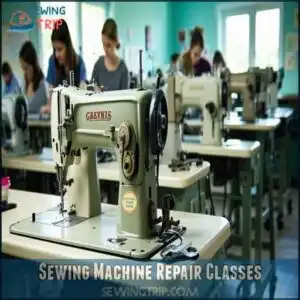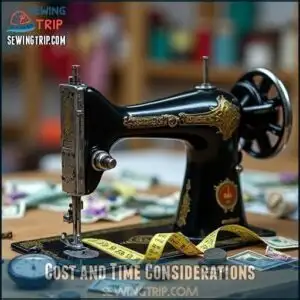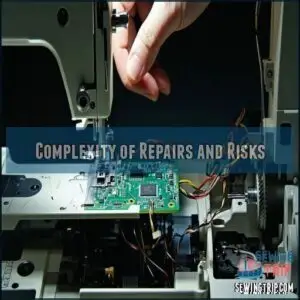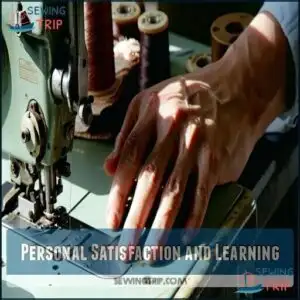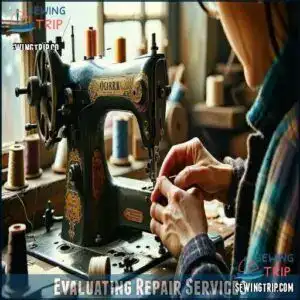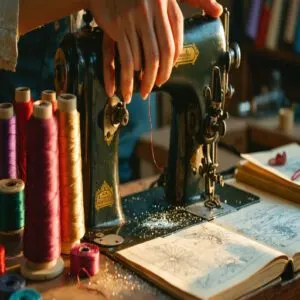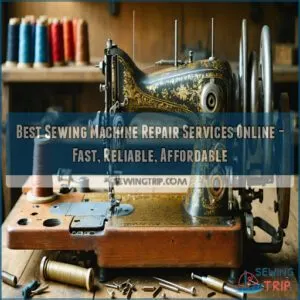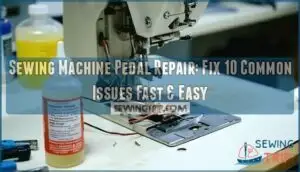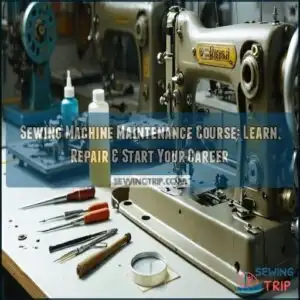This site is supported by our readers. We may earn a commission, at no cost to you, if you purchase through links.

Start by checking manufacturer websites or local sewing shops—they often have certified pros on hand. Online directories and reviews can also help you spot trusted technicians in your area.
Don’t overlook sewing forums or local quilting groups; fellow enthusiasts usually know the best people for the job. Word of mouth is gold here—ask friends who sew.
Look for someone with certifications or factory training for added peace of mind. A skilled tech saves time, money, and frustration.
Ready to explore deeper options? There’s more to learn just ahead.
Table Of Contents
Key Takeaways
- Check manufacturer websites for factory-trained technicians and certified repair professionals in your area.
- Use online directories and reviews to compare service quality and customer feedback.
- Ask local sewing groups or forums for trusted technician recommendations.
- Look for certifications or factory training to ensure quality repairs and access to genuine parts.
Finding Local Technicians
You’ll find qualified local sewing technicians faster when you know exactly where to look in your community.
Check manufacturer websites, browse online directories with reviews, ask at fabric stores, or tap into local sewing groups where everyone has that one repair person they swear by.
Checking Manufacturer Websites
Many manufacturer websites feature easy-to-use service locators that connect you to qualified technicians in your area.
Simply navigate to your machine manufacturer’s site and look for "Service" or "Support" sections.
These resources list factory-trained, certified technicians who specialize in your specific model.
You’ll often find part verification tools and update information too—ensuring your machine gets exactly what it needs from an authorized repair professional, which can be found through the factory-trained technicians.
Online Directories and Reviews
Online directories and reviews simplify finding local sewing technicians.
Use websites like Yelp or Google Maps to check ratings and customer feedback. For accuracy, focus on filtering options to sort by service quality and review authenticity.
Don’t forget mobile accessibility—easily compare while shopping.
Check these three tools:
- Online search engines
- Local classifieds
- Sewing forums for insider tips
Local Sewing Communities
Dozens of local sewing communities can lead you to trusted technicians.
Join sewing circles or community workshops where members often share experiences with repair services.
Local quilting groups frequently maintain lists of vetted technicians who specialize in specific machines.
Attend skill sharing events or group projects to connect with experts directly.
Don’t overlook online sewing forums with local sections—they’re goldmines for finding technicians who understand your specific needs, and can provide valuable insights from local sections.
Word of Mouth Referrals
Don’t overlook the power of word-of-mouth referrals when searching for a qualified technician.
Your local sewing circles often have members who’ve worked with trusted technicians and can share their personal experiences. These community recommendations typically provide more honest feedback than online reviews.
Ask specific questions about repair quality, pricing, and customer service. Local groups are goldmines for finding technicians who’ve earned genuine customer trust.
Sewing Machine Repair Classes
You’ll find quality technicians by taking repair classes offered at specialized institutes like Fix Sewing Machines or Singer workshops.
These classes provide hands-on training that teaches you to spot qualified professionals or fix simple problems yourself, saving you time and money when your machine starts making that dreaded grinding noise.
This approach allows you to address issues efficiently, and by learning from these classes, you can save time and money in the long run.
Traditional Classroom Training
Traditional classroom training gives you three critical advantages in your journey to become a sewing machine technician:
- Direct access to instructors with extensive repair experience
- Hands-on learning opportunities with various machine models
- Structured curriculum that builds skills systematically
You’ll benefit from immediate feedback as you work through problems.
The classroom setting also creates networking opportunities with fellow students who share your interests. Most vocational schools offer certification upon completion.
Online Courses and Tutorials
While classroom training offers hands-on practice, you can now learn sewing machine repair from the comfort of your home.
Online Accessibility makes technician training possible for anyone with internet access. YouTube tutorials and online courses provide flexible learning options that fit your schedule.
Many people find success using a sewing machine guide when learning at home.
| Learning Style | Cost Comparison | Skill Development |
|---|---|---|
| Visual Learners | $0-$300 (vs $1000+) | DIY troubleshooting |
| Independent | Pay-as-you-go options | Basic to advanced |
| Structured | One-time purchases | Remote assistance |
| Hands-on | Subscription models | Practice at your pace |
Vocational Schools and Certification
Vocational schools offer a solid foundation for aspiring sewing machine technicians.
You’ll find specialized curriculum covering mechanical and electronic repairs, with hands-on training that builds real-world skills.
Certification programs like MSDP and MAS validate your expertise, giving customers confidence in your abilities.
When choosing a program, consider the school reputation, program costs, and whether they provide industry-recognized credentials that will open doors to repair shops or manufacturing positions.
Apprenticeship Programs
While certificates look impressive on paper, hands-on apprenticeship programs offer real-world experience alongside qualified technicians.
You’ll earn an apprentice salary while developing skills through structured mentorship.
- Program structure typically includes 1-2 years of supervised work
- Factory-trained technicians share expertise that can’t be taught in classrooms
- Skill development happens organically through daily problem-solving
- Mentorship benefits include industry connections and job placement
The growing industry demand makes this path particularly valuable for aspiring technicians, with real-world experience and qualified technicians being key to success.
Technician Qualifications
You’ll want to look for technicians with proper certification from recognized institutions like Fix Sewing Machines Institute or factory training directly from manufacturers such as Singer.
The right qualifications guarantee your machine gets expert care from someone who understands its specific mechanisms, saving you from costly repairs down the road.
Certification Programs
After exploring repair classes, you’ll want to check a technician’s certification credentials.
Reputable certification programs like Sewing Doc Academy and Sewing Machines Institute offer multi-level credentials that verify a technician’s expertise.
These programs require hands-on practice and thorough training across mechanical, electronic, and computerized machines.
When hiring, look for industry recognition and program accreditation—certified technicians have proven their skills and commitment to quality sewing machine repair.
Factory Training and Authorization
Behind every exceptional repair job stands a factory-trained technician.
A factory-trained technician ensures precision, genuine parts, and unmatched expertise for every sewing machine repair.
When you choose authorized repair services, you’re getting professionals who’ve received manufacturer-specific training on complex models.
These qualified technicians have access to genuine parts, specialized diagnostic tools, and factory updates unavailable to others.
This expertise guarantees warranty validation and proper servicing of your machine—especially important for computerized models that require technical know-how beyond basic mechanics, ensuring the work is done by someone with the right technical know-how.
Experience and Specialization
Three key aspects separate an average repair person from a qualified technician: experience level, machine-specific knowledge, and problem-solving abilities. When evaluating a sewing machine mechanic’s expertise, pay attention to their specialization.
Many shops offer nationwide service coverage for convenience.
- Brand Expertise: Some technicians excel with Singer machines but struggle with Bernina models
- Machine Types: Seek specialists who understand both computerized and mechanical systems
- Repair Complexity: Experienced technicians can tackle timing issues and motor replacements
- Diagnostic Skills: Factory-trained technicians quickly identify problems others miss
- Problem Solving: Certified technicians find creative solutions for discontinued parts
Benefits of Certified Technicians
You’ll gain peace of mind knowing your cherished sewing machine is in the hands of someone who’s factory-trained with access to genuine parts and specialized tools.
Certified technicians also provide warranty protection on their work, ensuring your machine runs smoothly for years to come with warranty protection.
Warranty and Liability Protection
While proper training matters, the protection you receive from certified technicians is equally valuable.
When your technician has liability insurance, you’re covered if something goes wrong during repairs. Most certified pros offer warranties that protect your investment for up to a year.
Look for extended warranty options like 3-year plans that include free shipping and zero out-of-pocket expenses. Remember: authentic parts and proper coverage give you legal recourse if problems arise.
Expertise and Quality of Work
Certified technicians bring repair expertise that’s worth its weight in gold.
You’ll notice the difference in both the process and results when you choose qualified professionals for your sewing machine.
- Advanced diagnostic accuracy identifies problems other technicians might miss
- Factory-trained technicians understand the intricacies of specific brands
- Part authenticity guarantees your machine functions as designed
- Repair complexity doesn’t intimidate experts with years of experience
- Repair warranties often reflect a technician’s confidence in their own work
This structure ensures that you get the best service for your sewing machine, with qualified professionals providing advanced diagnostic accuracy.
Customer Confidence and Trust
You’ll sleep better at night knowing your beloved sewing machine is in trusted hands.
Rest easy knowing skilled hands are expertly caring for your cherished sewing machine.
Certified technicians build customer confidence through transparent service practices and clear repair guarantees.
When a qualified technician explains each step of the process, you naturally feel more at ease.
Their credibility is often backed by customer feedback and online reviews, which further supports ethical practices in communication and pricing.
This combination of transparency and accountability helps cement the trustworthy technician-customer relationship that keeps you coming back.
Access to Specialized Tools and Parts
When you work with a qualified technician, you’re gaining access to a treasure trove of specialized tools and genuine parts that aren’t available to the general public.
This advantage can’t be overstated. Technicians often offer 90-day warranty coverage for added peace of mind.
The benefits of working with a technician include:
- Diagnostic equipment that pinpoints issues with computerized accuracy
- Genuine parts from manufacturers, ensuring perfect fit and function
- Specialized tools designed specifically for your machine model
- Extensive parts inventory that prevents lengthy repair delays
- Direct sourcing connections that bypass common availability difficulties
DIY Repair Vs Professional Service
You’ll need to weigh the satisfaction of fixing your sewing machine yourself against the expertise a professional brings to complex repairs.
While DIY options can save money and teach you valuable skills, a qualified technician offers specialized tools and knowledge that protect your investment for years to come, which is a key consideration for the long-term protection of your sewing machine.
Cost and Time Considerations
While certified technicians offer expertise, you’ll want to weigh the financial aspects of your repair decision.
Professional services have costs and timeframes that vary substantially.
| Cost Factor | DIY Approach | Professional Service |
|---|---|---|
| Initial Investment | $15-30 for tools | $75-100 per tune-up |
| Time Required | 1-3 hours learning | 1-day to 2-week turnaround |
| Hidden Fees | None | Parts replacement extra |
| Long-term Savings | High with practice | Warranty protection |
Remember to get multiple repair estimates as price comparison can reveal considerable variations in service pricing.
Regular maintenance can prevent common sewing problems.
Local technicians typically offer faster turnaround times than shipping your machine away, and this can be a significant factor in your decision, considering the time required for each approach, as well as the potential for long-term savings and the presence of hidden fees.
Complexity of Repairs and Risks
Determining repair complexity is like solving a puzzle—some pieces fit easily while others require expert hands. You’ll face varying degrees of risk based on your machine type and the specific issue.
| Repair Type | Difficulty Level | DIY Risk |
|---|---|---|
| Tension adjustment | Low | Minimal |
| Belt replacement | Medium | Moderate |
| Computerized repairs | High | Significant |
Complex repairs, especially in computerized models, often lead to component failure when attempted by untrained hands. You can find resources for computerized sewing products online. Consider the damage potential and irreversible errors before attempting machine troubleshooting.
Personal Satisfaction and Learning
While complex repairs carry risks, fixing your own machine offers unique rewards beyond saving money.
You’ll develop valuable skills and gain deeper understanding of your sewing companion.
| Benefit | DIY Repair | Professional Service |
|---|---|---|
| Skill Development | High | None |
| Problem Solving | Builds confidence | Handled by technician |
| Machine Mastery | Complete understanding | Remains mysterious |
This creative outlet transforms you from user to expert.
When you successfully diagnose that strange noise, you’ll feel a satisfaction no qualified technician can provide—though their services remain invaluable for certain situations, providing a sense of complete understanding and machine mastery, and helping you build confidence as you work on your sewing companion.
Evaluating Repair Services
You’ll save yourself a lot of headaches by carefully checking a repair service’s reputation, pricing, and warranty options before handing over your beloved sewing machine.
Don’t just pick the first technician you find—take time to read customer reviews and ask about their turnaround time so you can get back to your projects without unnecessary delays, which will also help you understand their overall reputation.
Reputation and Customer Reviews
While DIY fixes have their place, sometimes you need a pro. But how do you know who’s trustworthy?
Start by checking online reviews across multiple platforms. Look for rating consistency and review authenticity—glowing reviews that sound too perfect might be fake.
Analyze customer feedback patterns and pay attention to how businesses handle negative comments.
Local recommendations often carry more weight than anonymous online reviews. Your sewing community’s firsthand experiences provide valuable insight into a technician’s reputation management practices.
Pricing and Estimates
Looking at customer reviews only tells part of the story.
In matters of pricing and estimates, you’ll want to understand what you’re actually paying for. Basic mechanical service starts around $119, with repair costs varying based on your machine’s complexity.
Ask for price transparency and what the estimate includes. Regular maintenance can prevent costly future repairs and extend the life of your machine.
Watch for hidden fees and compare repair quotes from different technicians. Remember, the cheapest option isn’t always the best value.
Turnaround Time and Communication
When evaluating repair services, consider both turnaround time and communication quality.
Ask for an estimated repair time upfront and how the technician provides updates.
Fast and reliable service matters, but so does clear communication about the repair process.
Good technicians explain potential delays, maintain update frequency through your preferred communication methods, and follow up post-repair.
Customer feedback often highlights excellent communicators who keep clients informed throughout, emphasizing the importance of clear communication and reliable service.
Warranty and Support Options
When checking out warranty and support options from repair shops, don’t overlook the fine print on those service contracts.
Extended warranties can save you money in the long run, especially for computerized machines.
Most reputable technicians offer 90-day repair guarantees and warranty protection on parts and labor.
Ask about warranty types, parts availability, and how warranty claims are processed before committing to a 90-day repair guarantee.
Becoming a Sewing Technician
You’ll need proper training through certification programs or apprenticeships to become a qualified sewing technician who can diagnose and fix various machine issues.
You can choose from traditional classroom settings, online courses, or hands-on experience to build your skills, with costs ranging from $100 for community college classes to over $3,000 for specialized institute programs.
This will help you gain the necessary skills to work with various machines and fix issues, making you a skilled sewing technician.
Training and Certification Paths
After evaluating repair services, you might wonder how to become a qualified technician yourself.
The path to becoming a certified sewing machine technician offers several routes:
- Certification programs through specialized schools like Fix Sewing Machines Institute provide credibility
- Vocational training offers hands-on experience with proper equipment
- Online learning platforms allow flexible study while maintaining your current job
- Apprenticeships pair you with factory-trained professionals for real-world experience
- Specialized schools often include business training alongside technical skills
Gaining Experience and Building Skills
Hands-on practice is the cornerstone of developing your repair skills.
Start with basic maintenance on your own machine before gradually tackling more complex issues. Seek mentorship opportunities through local repair shops willing to share knowledge.
Diversify your skills by working on different machine brands and models. Join online forums where professionals discuss troubleshooting techniques.
Understanding various machine components is also essential for effective repairs. Remember, sewing machine mechanics requires patience—each repair builds confidence and expertise.
Staying Up-to-Date With Industry Developments
The sewing machine industry never stands still. To thrive as a technician, you must keep pace with rapid changes.
Here’s how to stay current:
- Attend industry conferences showcasing emerging technologies
- Follow repair technique blogs and diagnostic software updates
- Subscribe to parts sourcing newsletters
- Watch YouTube tutorials on machine evolution
- Participate in factory-trained technician forums
Don’t let outdated knowledge unravel your success. Stay updated to ensure you remain a skilled technician in the ever-evolving sewing machine industry, and remember to always keep pace with emerging technologies.
Joining Professional Networks and Associations
While staying current with industry trends improves your technical skills, building professional connections can take your career to new heights.
Join sewing associations to access Network Benefits like client referrals and discounted events. Most chapters require just $15-50 in annual dues, making membership affordable for any sewing machine specialist.
Association Resources include sample contracts and business templates, while meetups offer Skill Development opportunities. Local sewing technicians can find community through platforms like Meetup.
Frequently Asked Questions (FAQs)
How do I find a sewing machine repair technician?
Think of your sewing machine as a delicate melody needing fine-tuning.
Search manufacturer websites, local dealers, sewing forums, or online classifieds.
Check for reviews, certifications, and warranties to guarantee reliable, experienced repair technicians, ensuring you find a service that will properly fine-tune your machine.
Where can you find sewing machine repair classes?
You can find sewing machine repair classes through schools like Fix Sewing Machines Institute and White Sewing Center, local trade schools, community colleges, or even online platforms.
These platforms offer flexible training options for beginners and professionals alike.
What training do you need to repair a sewing machine?
It’s funny how fixing machines can fix your day too.
To repair sewing machines, you’ll need certification, hands-on training, and basic tools.
Online classes or workshops build skills and credibility, boosting confidence and career potential.
How do I get a sewing machine certification?
To get certified, enroll in programs like the Fix Sewing Machines Institute or Singer’s workshops.
Many vocational schools and online courses also offer certifications.
Certification boosts credibility, helping you stand out as a professional technician.
Should you hire a sewing machine repair service?
Hiring a sewing machine repair service guarantees expert care, saves time, and prevents worsening issues.
Professionals handle complex repairs, use proper tools, and offer warranties.
It’s a smart choice, especially for modern or expensive machines.
Should you hire a Tasker for sewing machine repair?
Think of a Tasker as a jack-of-all-trades.
While they’re great for simple fixes, sewing machines often need specialized care.
For complex issues, certified technicians with proper training and tools are the safer bet.
What is a sewing technician?
A sewing technician is a trained professional who repairs, maintains, and tunes up sewing machines.
They diagnose issues, replace parts, and guarantee your machine runs smoothly, whether it’s for hobby projects or high-demand work.
How much does a sewing machine technician make?
A sewing machine technician typically earns between $30,000 to $60,000 annually, depending on location, skill level, and certifications. Experienced techs or those in high-demand areas can make even more with specialized expertise.
What is a degree in sewing called?
Picture a thread weaving through fabric—there’s no specific "degree" in sewing, but programs like fashion design or textile arts cover it.
Certifications, workshops, or trade school courses can also hone your sewing expertise.
Can I make a living from sewing?
Yes, you can!
Many sewists earn through custom clothing, alterations, quilting, or selling handmade items online.
Building skills, creating a niche, and networking help turn your passion for sewing into a solid income.
Conclusion
Finding a qualified sewing technician doesn’t have to feel like searching for a needle in a haystack.
Start with trusted resources like manufacturer websites, local sewing communities, or personal referrals. Check for certifications or factory training to guarantee reliable service.
Remember, investing time upfront saves headaches later. Whether it’s a simple fix or a major repair, finding the right expert pays off in quality and confidence.
Now you’re ready to find the perfect technician!


